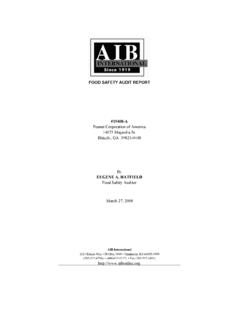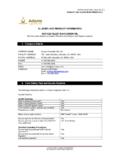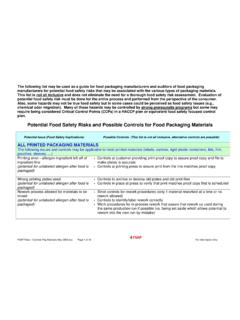Transcription of FOOD SAFETY AUDIT REPORT - Pulitzer
1 food SAFETY AUDIT REPORT #19408-APeanut Corporation of America14075 Magnolia , GA 39823-0448 ByEUGENE A. HATFIELDFood SAFETY AuditorMarch 27, 2008 AIB International1213 Bakers Way PO Box 3999 Manhattan, KS 66505-3999(785-537-4750) (800-633-5137) Fax (785-537-1493) food SAFETY AUDIT was conducted at this facility on March 27, 2008. The writer was accompanied throughout the AUDIT by Mr. Danny Kilgore, Operations Manager; and Ms. Annie Bristow, Janitorial and Sanitation Director. Excellent cooperation was received by the writer, and on some occasions, the items were immediately corrected. At the conclusion of the AUDIT , a meeting was held to discuss the observations, recommendations, and rating The meeting was held with Mr Danny Kilgore, Operations Manager. Based on the observations made, the information obtained, and the criteria set forth in the AIB Consolidated Standards for food SAFETY , the overall food SAFETY level of this facility was considered to be: SUPERIOR(910)The serious or unsatisfactory items are shaded, boxed, and bolded in the text of the REPORT .
2 Refer to the definitions in the AIB Consolidated improvement needed items are designated in bold type and require prompt AIB International states that the REPORT as given herein is to be construed as its findings and recommendations as of the date of this REPORT . The AIB International accepts no responsibility and does not assume any responsibility for the food SAFETY program in effect with (customer). That further AIB International is only making REPORT of the food SAFETY conditions of (customer) as of the date of this REPORT and assumes no responsibility or liability as to whether (customer) carries out the recommendations as contained in this REPORT or does not carry out the recommendations as contained in this REPORT .# OF food SAFETY PROGRAM 175 PEST control 195 OPERATIONAL METHODS AND PERSONNEL PRACTICES 175 MAINTENANCE FOR food SAFETY 175 CLEANING PRACTICES 190 RATING ANALYSISDATE OF AUDIT : TYPE OF AUDIT : AnnouncedOVERALL RATING: SUPERIORTOTAL.
3 910 March 27, 2008# FREQUENCY REPORT (IFR)SERUN*TBACPMSOPPCAPPLANT OVERVIEW 3 2 1 0 1 7 0 0 EXTERIOR AND ROOF 0 0 0 1 0 1 0 0 SUPPORT AREAS 0 0 0 1 0 1 0 0 MAINTENANCE AREAS 0 0 1 0 0 1 0 0 WAREHOUSE 0 0 0 0 0 0 0 0 PEANUT BUTTER AND PASTE OPERATIONS 0 0 1 2 2 5 0 0 TOTAL ITEMS BY CATEGORY 3 2 3 4 3 0 0*TBA = TOTAL ITEMS BY AREAAP = Adequacy of food SAFETY ProgramMS = Maintenance for food SafetyPC = Pest ControlCP = Cleaning PracticesOP = Operational Methods and Personnel PracticesUN = UnsatisfactorySER = Serious# OBSERVATIONS AND SPECIFIC RECOMMENDATIONSPLANT OVERVIEWCOMA current organizational chart dated January 12, 2008, was maintained.
4 The responsibility and authority for ensuring food SAFETY and security, and the facility's compliance with federal, state, governmental, and/or any other appropriate regulatory laws or guidelines were clearly assigned to the Operations Manager. This responsible person remains up to date on regulatory issues and has obtained the required regulatory food security registration dated 11/0 food SAFETY Manual had been developed. This manual included work instructions and/or job descriptions outlining the specific responsibilities of each department manager and employees, a Quality Policy signed by the Company President with a revision date of January 28, 2006, and written policies for the programs listed in the AIB Consolidated Standards for food facility had established a multidisciplinary food SAFETY committee to conduct monthly inspections of the entire plant.
5 Inspections were generally performed by the Operations Manager and/or Janitorial/Sanitation Director. Documentation of the monthly inspections included identified deficiencies, specific assignments, and actual accomplishments. Inspections reviewed included January, 2008, February, 2008, and March, 2008. Follow-up inspections were done to ensure that the items were corrected. In addition, systems and procedures critical to product SAFETY and quality were audited to ensure they were in place, appropriate, and complied with. This AUDIT was performed by the Quality Assurance Manager and Operations Manager annually, most recently on January 12, 2008, by the Operations Manager. Continued attention to items that had the potential to impact product zones was recommended. Items such as the paste room hoist maintenance, cleaning and sealing gaps in vertical support beams, and open ingredient containers in the peanut butter mixing area.
6 (IMPROVEMENT NEEDED) facility appeared to maintain an adequate budget and support to maintain the proper and timely acquisition of appropriate tools, materials, equipment, monitoring devices, chemicals, and pest control # Master Cleaning Schedule (MCS) and a daily housekeeping schedule were developed as a formalized, written plan and implemented in this facility. This MCS specified frequency and responsibility. Postcleaning evaluations were conducted. The schedules were documented as current, and the conditions observed in the plant supported the documentation. The schedule included the outside grounds, buildings, drains, and equipment. The schedule was reviewed periodically to ensure that it was still applicable. Continued emphasis on cleaning the edges around the peanut butter pour-up stations and the floor/wall junctions and gaps in the paste room were , written cleaning procedures were developed and on file for all cleaning tasks in the facility.
7 These procedures included the chemicals, concentrations, tools, and disassembly instructions for equipment at the level needed to facilitate the appropriate sanitation maintenance of the processing and packaging equipment, building areas, and outside grounds. Specific cleaning procedures were developed to prevent cross-contamination amid allergen and non-allergen-containing goods and ingredients received into the facility were inspected according to established written procedures. The incoming goods were checked for damage, cleanliness, and pest activity. The receiving records included date of receipt, carrier, lot number, amount, seal numbers (when applicable), and product and vehicle conditions. Raw materials that contain allergens or are susceptible to mycotoxins, autolysis from temperature abuse, or pathogenic microorganisms were segregated and covered by a separate written procedure with appropriate deliveries of liquid materials included a visual inspection both before and after unloading.
8 Verification was conducted that hatch and hose seals matched those listed on the bill of lading to ensure load integrity in transit. The findings were specifications were on file for the raw materials, packaging materials, finished products, and intermediate/semiprocessed products. These specifications were detailed to ensure compliance with relevant food SAFETY and legislative requirements. These specifications were periodically reviewed and formally agreed upon with relevant of analysis and/or supplier guarantees for raw materials, food packaging, and finished products were maintained on # Hazard analysis critical control Point ( haccp ) program had been developed and implemented for all processes and process lines. The program included the following components: Description of the products manufactured and hazards inherent to them, determined through risk assessment; Identification of critical control points (CCP) and critical limits; Procedures to control the CCPs; Determination of the monitoring frequency for the CCPs and designation of the person(s) responsible for testing; Established and documented deviation procedures; Written verification program, with proper documentation; Documentation of procedures, records of conformance, and corrective actions.
9 This facility had evaluated the processes and procedures and determined that no critical control points were present in the operation. The designated monitoring control points (MCPs) were specified and described. The most recent program reassessment had been performed by the Operations Manager on January 12, company had established written employee and Good Manufacturing Practices (GMPs) policies. Specific written procedures were on file for providing food SAFETY training to all personnel, including temporary personnel and contractors. Employees also attended monthly food SAFETY meetings that reviewed different aspects of food SAFETY and GMPs. Records of training completion for new employees and annual refresher training documentation were maintained for all personnel. The most recent employee meeting was held on 03/05/08.
10 Items covered included AIB, GMP, hand sanitation, spillage and clean-up. The annual employee training was held in January and February, written program for evaluating consumer complaints was established at this location. This program included the rapid dissemination of complaint information to all departments responsible for implementing the food SAFETY program. Complaint information was used, where appropriate, to avoid recurrence and implement ongoing improvements to product SAFETY , legality, and quality. Actions appropriate to the seriousness and frequency of the problems identified appeared to be carried out promptly and written recall program was on file. All finished products were coded. Product traceability was accomplished through the recording of raw material lot numbers on production records, and included source identification for work in progress and rework.






